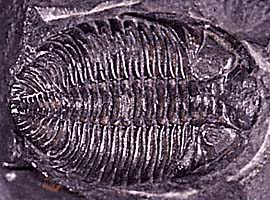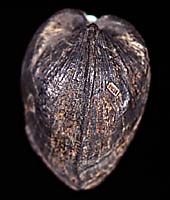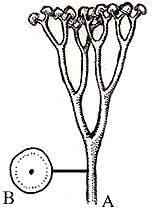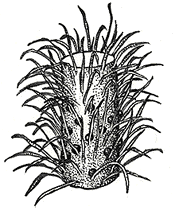





The Silurian is a time when many biologically significant events occurred. In the oceans, there was a widespread radiation of crinoids, a continued proliferation and expansion of the brachiopods, and the oldest known fossils of coral reefs. The time period also marks the wide and rapid spread of jawless fish, along with the important appearances of both the first known freshwater fish and the appearance of jawed fish. Other marine fossils commonly found throughout the Silurian record include trilobites, graptolites, conodonts, corals, stromatoporoids, and mollusks.
 |
 |
Silurian Critters : On the left, Dalmanites limuluris, a trilobite from the Silurian of New York. To the right, Grammysia cingulata, a brachiopod from the Upper Ludlow of England.
It is also in the Silurian that we find the first clear evidence of life on land. While it is possible that plants and animals first moved onto the land in the Ordovician, fossils of terrestrial life from that period are fragmentary and difficult to interpret. Silurian strata have provided likely ascomycete fossils (a group of fungi), as well as remains of the first arachnids and centipedes.
Perhaps most striking of all biological events in the Silurian was the evolution of vascular plants, which have been the basis of terrestrial ecology since their appearance. Most Silurian plant fossils have been assigned to the genus Cooksonia, a collection of branching-stemmed plants which produced sporangia at their tips. None of these plants had leaves, and some appear to have lacked vascular tissue. Also from the Silurian of Australia comes a controversial fossil of Baragwanathia, a lycophyte. If such a complex plant with leaves and a fully-developed vascular system was present by this time, then surely plants must have been around already by the Ordovician. In any event, the Silurian was a time for important events in the history of evolution, including many "firsts," that would prove highly consequential for the future of life on earth.
 |
 |
Early Plants : Cooksonia, on the left, has usually been considered the oldest known land plant. Fossils assigned to several species are known from North America, Europe, Asia, and Africa, and from both the Late Silurian and Early Devonian. The lycophyte Baragwanathia, on the right, is structurally more complex than Cooksonia, but Silurian fossils of this plant have been found in Australia, significantly earlier than in the Northern Hemisphere.
For more about life in the oceans of the Silurian, visit the Virtual Silurian Reef at the Milwaukee Public Museum.
For more about early land plants, visit the Virtual Paleobotany Lab.
Find out more about the Silurian paleontology and geology of North America at the Paleontology Portal.

T. N. Taylor & E. L. Taylor. 1993. The Biology and Evolution of Fossil Plants. Prentice Hall, NJ.
Plant images drawn by Caroline Stromberg; fossils photographed by Brian R. Speer from the UCMP collections.

